Page Contents:
Tree Planting Zones and Sub-Principles for 11 Settlements
Fishguard and Goodwick tree planting zones and sub-principles.
Haverfordwest tree planting zones and sub-principles.
Milford Haven tree planting zones and sub-principles.
Narberth tree planting zones and sub-principles.
Newport tree planting zones and sub-principles.
Neyland tree planting zones and sub-principles.
Pembroke tree planting zones and sub-principles.
Pembroke Dock tree planting zones and sub-principles.
Saundersfoot tree planting zones and sub-principles.
St Davids tree planting zones and sub-principles.
Tenby tree planting zones and sub-principles.
Tree Planting Zones and Sub-Principles for 11 Settlements
3.1 Strategic Tree Planting Zones have been established for each settlement and can be accessed via the links below. Each Strategic Tree Planting Zone has a set of accompanying Sub-Principles, which build on the Overarching Principles and provide additional detail to inform the future delivery of tree planting projects.
3.2 Tree planting typologies have also been developed, outlining species recommendations and tree planting guidance for specific environmental conditions.
- Fishguard and Goodwick tree planting zones and sub-principles.
- Haverfordwest tree planting zones and sub-principles.
- Milford Haven tree planting zones and sub-principles.
- Narberth tree planting zones and sub-principles.
- Newport tree planting zones and sub-principles.
- Neyland tree planting zones and sub-principles.
- Pembroke tree planting zones and sub-principles.
- Pembroke Dock tree planting zones and sub-principles.
- Saundersfoot tree planting zones and sub-principles.
- St Davids tree planting zones and sub-principles.
- Tenby tree planting zones and sub-principles.
Fishguard and Goodwick Tree Planting Zones and Sub-Principles
3.3 Tree Planting Zones and Sub-Principles for Fishguard and Goodwick are shown on the map and below. They include:
- Fishguard and Goodwick historic cores
- Utilise tree planting to soften the existing urban character of the narrow street pattern within each town, whilst taking advantage of their coastal position.
- New Hill and Quay Road
- Introduce tree planting species which complement the steep gradient of land overlooking Fishguard Harbour, whist retaining locally elevated coastal views.
- Fishguard Bay and seafront
- Introduce tree species suitable for waterside environments to ensure visual permeability and the retention of open views across Fishguard Harbour.
- Maesgwynne Fringe
- Introduce tree planting species which complements the rural setting at the fringes of Fishguard.
- A487 industrial and commercial
- Soften the inductrial and commercial context on land at bordering the A487.
- Fishguard and Goodwick residential
- Enhance the setting of residential areas whilst complementing local topography and coastal environments. Promote acceptance of tree planting proposals with the local community to increase the likelihood of long-term establishmen
Figure 3.1: Fishguard and Goodwick Strategic Tree Planting Zones
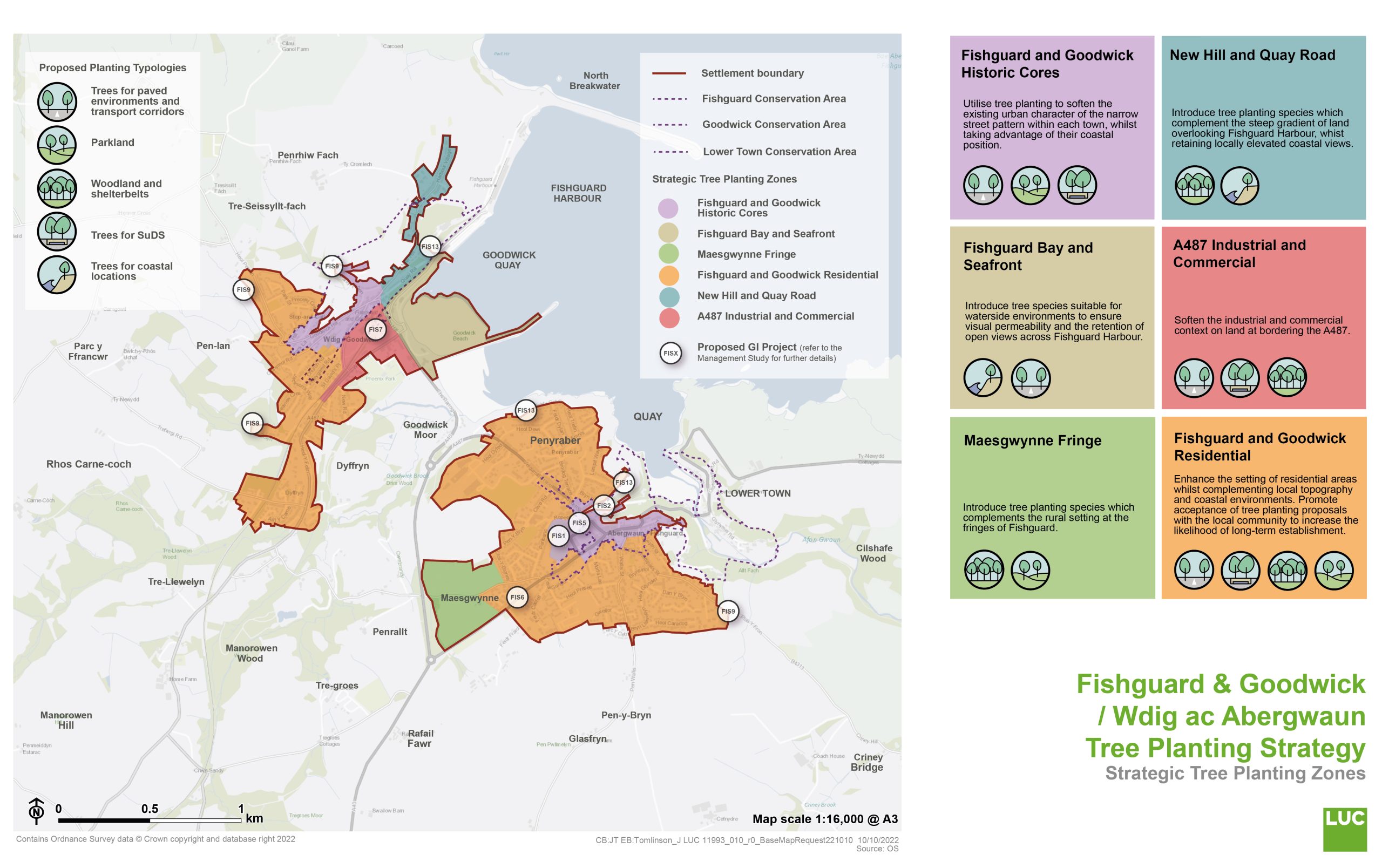
Zones and Sub-Principles
3.4 Land encompassed within Fishguard Conservation Area (CA), Goodwick CA and Lower Town CA includes the spaces between buildings and existing trees within the designation. All planting proposals and management of existing trees located within and adjacent to Conservation Areas should be planned in consultation with both the Historic Building Conservation Officer and Landscape Officer at PCC.
Fishguard and Goodwick’s historic cores
- Review landscape management practices to ensure the retention of panoramic harbourside views at key locations along the Slade and Penslade in Fishguard. Longer distance views towards the wider coastline, the hills of Dinas and Newport to the North should also be restored at strategic locations along the footway.
- Promote the integration of tree planting, particularly in locations where there is little presence of trees to promote a positive contribution to townscape character. Whilst trees are not a defining characteristic of the historic urban areas and town centre (such as Fishguard High Street / West Street), opportunities should be sought to soften the built environment. Tree planting should enhance and not detract from the setting of heritage assets and distinctive street pattern within Fishguard and Goodwick Conservation Areas. Tree planting proposals should have regard to the orientation of existing built features. This includes responding to the pattern of the streetscape in terms of bays and ‘nodes’ which break up the façade.
- Due to the distinctive nature of the topography in Fishguard, tree planting proposals should be sensitively integrated along High Street and Kensington Street in order to retain the availability of long distance views. Similarly, the hillside setting of Goodwick significantly contributes to the character and setting of the town and long distance views should be conserved. Tree planting along the length of narrow streets will generally be inappropriate. Trees may be best placed at key entrances, fringes and nearby wider junctions leading into the Conservation Area boundaries, utilising trees with a narrow form to maintain sightlines where needed.
- Tree planting should be used to add interest and diversity to any areas incidental green space within built up areas (such as at Fishguard one way system). Planting several additional large parkland trees within Lota Park should be prioritised as a key opportunity, diversifying the range of species.
Fishguard Bay and seafront
- Use tree planting to frame routes to and from Fishguard and Goodwick, at The Parrog.
- New planting should include renovation of existing ornamental planting areas and tree groups, incorporating ornamental trees to provide aesthetic interest and diversify the range of species.
- Ensure trees are selected and managed to maintain views to the bay and for safety, raising canopies where appropriate.
- Use trees to mark routes and entrances towards key facilities and seating areas, such as the play area, aquarium and car park.
- Ensure tree species are appropriately selected to withstand the exposed location.
- Where possible, place trees to screen views of infrastructure and industrial buildings associated with the ferry port.
Maesgwynne Fringe
- Use tree planting to mark the entrance to Fishguard from the north, utilising open roadside verges for low density tree planting along the edges of adjacent agricultural land.
- Use tree planting to soften the interface between surrounding rural areas and the urban fringe, seeking opportunities to engage local landowners.
- Connect and buffer existing shelter belts and small parcels of woodland by gapping up and thickening existing field boundaries; creating corridors between the urban forest and wider landscape.
Fishguard and Goodwick residential
- Utilise tree planting to enhance the setting of residential streets and complement views in more elevated areas. Sufficient consideration should be given to species selection, ultimate canopy size and maintenance requirements to promote long-term establishment and reduce interference with buildings and services (e.g. telegraph lines / lighting columns).
- Avoid proposals which conflict with private vehicular access points on residential streets.
- Prioritise tree planting in areas with the least site constraints, such as larger areas of amenity grassland and verges (e.g. around Stop and Call).
- Use tree planting to buffer and screen busy route corridors nearby residential areas (e.g. A487), utilising roadside verges for avenues or small groups of trees where appropriate. Where possible, incorporate trees within Sustainable Urban Drainage Systems or swales to reduce surface water run off from roads.
- Tree planting proposals should avoid obstruction of highways, footpaths of Public Rights of Way (PRoW) within the residential context.
- Promote community ownership of proposed tree planting to increase the likelihood of long-term establishment.
New Hill and Quay Road
- Tree planting at elevated, hilly residential areas should be low density, focussing on appropriately locating individual trees or small groups to compliment local topography. Key views towards the quay, harbour and local heritage assets should be maintained.
- Use tree planting to enhance the urban fringe and help reduce the visual impact of built development. Create links and buffer adjacent habitat areas and peri-urban woodlands, engaging with surround landowners where possible.
A487 industrial and commercial
- Utilise tree planting to screen and soften industrial and commercial areas.
- Prioritise planting in areas with least constraints and ‘quick win’ locations, including the boundaries of adjacent open spaces (e.g. Phoenix Park, Wern Road).
- Incorporate tree planting at Phoenix Road Car Park, utilising perimeter verges and greening the expanse of hard landscape. Avoid fruit bearing trees in areas where this may cause a nuisance.
Haverfordwest tree planting zones and sub-principles
3.5 Tree Planting Zones and Sub-Principles for Haverfordwest are shown on the map and below. They include:
- Haverfordwest and Merlin’s bridge residential
- Enhance the setting of residential areas and promote acceptance of tree planting proposals with the local community to increase the likelihood of long-term establishment.
- A40 Corridor
- Soften prominent route corridors to enhance the approach into Haverfordwest.
- Haverfordwest rural Fringe
- Introduce tree planting species which complements the rural settings at the fringes of the town.
- Historic Core and Western Cleddau Corridor
- Utilise tree planting to soften the compact historical core and seek to promote the Western Cleddau as one of the town’s best assets. Proposals should avoid any negative impacts on the setting of historically significant assets.
Figure 3.2: Haverfordwest Strategic Tree Planting Zones
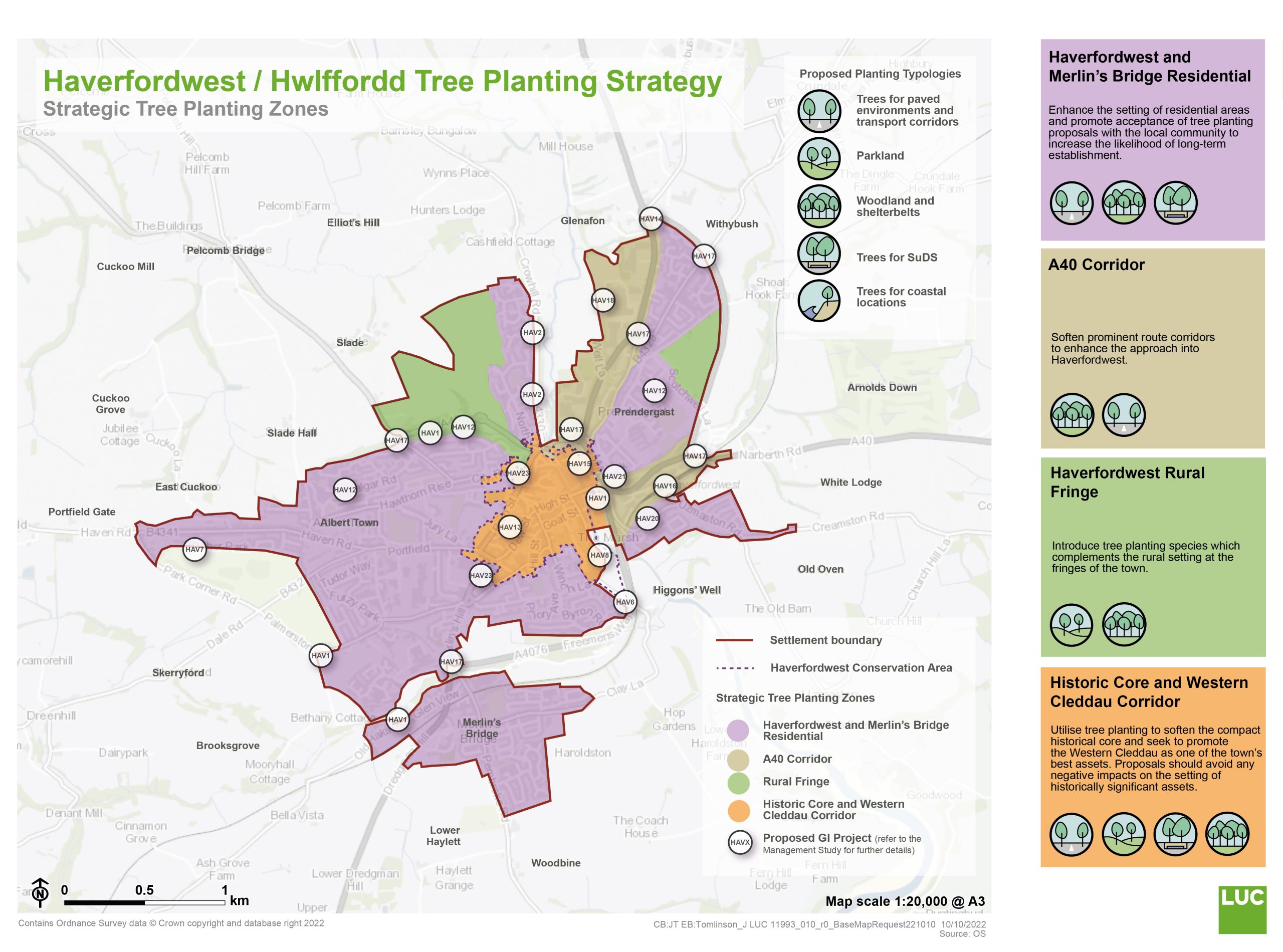
Zones and Sub-Principles
3.6 Land encompassed within Haverfordwest Conservation Area includes the spaces between buildings and existing trees within the designation. PCC should therefore be contacted prior to the commencement of works on existing trees subject to a Tree Preservation Order (TPO) or those located within the boundary of Haverfordwest Conservation Area.
Haverfordwest and Merlin’s Bridge residential
- Utilise tree planting to enhance the setting of residential areas, creating tree lined streets where possible. Sufficient consideration should be given to species selection, ultimate canopy size and maintenance requirements to promote long-term establishment and reduce interference with buildings and services (e.g. telegraph lines / lighting columns).
- Prioritise tree planting in areas with the least site constraints, such as larger areas of amenity grassland and verges, including areas with minimal recreational value due to slope / small size etc.
- Avoid proposals which conflict with private vehicular access points on residential streets.
- Tree planting proposals should avoid obstruction of highways and Public Rights of Way (PRoW) within the residential context.
- Incorporate tree planting across social housing sites, integrating well-spaced parkland trees where space allows. Ensure sightlines are maintained for safety. Avoid creating areas of dense planting that may encourage antisocial behaviour, prioritising well-spaced high canopy trees, or narrow fastigiate species. Consult with, and engage, nearby residents throughout the process to increase the likelihood of long term success. Ensure sufficient space between tree planting and residential dwellings to maintain views and access to light.
- Enhance tree canopy cover within parks and open spaces as a priority and key opportunity for incorporating larger trees in the urban context.
A40 Corridor
- Use tree planting to buffer and screen busy route corridors, industry and commercial buildings, utilising roadside verges for avenues or small groups of trees where appropriate. Where possible, incorporate trees within Sustainable Urban Drainage Systems or swales to reduce surface water run-off from roads and help enhance the quality of adjacent water courses.
- Use tree planting to mark key entrance points into the Haverfordwest. Prioritise the use of species with aesthetic quality such as spring blossom at key gateway areas.
- Ensure replacement planting of existing trees (e.g. at roundabouts) is an ongoing requirement, to maintain or increase canopy cover.
- Implement positive management and protection of adjacent existing woodland (e.g. Scotchwell Woodland) as a key asset; providing multiple environmental benefits and visual screening of the road.
Haverfordwest rural Fringe
- Enhance the interface between the fringes of the urban area and the surrounding rural area. Strengthen and restore field boundaries through additional planting and the incorporation of standard trees.
- Create additional links between the urban area and small fragmented areas of surrounding woodland.
Historic Core and Western Cleddau Corridor
- Ensure that tree planting proposals enhance the setting of the compact urban core and reinforce the distinctive street pattern within Haverfordwest Conservation Area. Proposals should avoid detrimental impacts on heritage assets. All planting proposals should be prepared in conjunction with both the Historic Building Conservation Officer and Landscape Officer at PCC.
- Utilise tree planning to frame views and link the urban setting of Haverfordwest Conservation Area to the surrounding rural landscape.
- Opportunities should be sought for the integration of tree planting to provide a positive contribution to the townscape character and appearance. Specific opportunities include tree planting at key nodes within the street network and in public spaces.
- Review and reconfigure parking provision in the town centre (e.g. Dew Street) to incorporate trees within the dense urban environment, where the opportunity arises. Small sections of on street parking could be re-configured to provide greater width and rooting environment for the growth of suitable street trees.
- Mark entrance points to the historic core area with tree planting and continue to increase tree cover, including designed SuDS, along the river (e.g., nearby the Riverside Shopping Centre).
Milford Haven tree planting zones and sub-principles
3.7 Tree Planting Zones and Sub-Principles for Milford Haven are shown on the map and below. They include:
- Hubberston and Hakin
- Enhance the setting of residential areas and promote acceptance of tree planting proposals with the local community to increase the likelihood of the long-term establishment.
- Marina and Mackerel Quay
- Introduce tree species suitable for waterside environments to ensure visual permeability and the retention of open views across Milford Haven.
- Thornton industrial estate
- Soften the industrial and commercial context on land at Thornton industrial estate.
- Town Centre grid pattern and dense urban core
- Utilise tree planting to enhance the grid pattern and provide a positive contribution to the character of the town centre.
- The Rath and Castle Pill
- Introduce tree planting species which complement the setting of Castle Pill and retain locally elevated views out across Milford Haven.
Figure 3.3: Milford Haven Strategic Tree Planting Zones
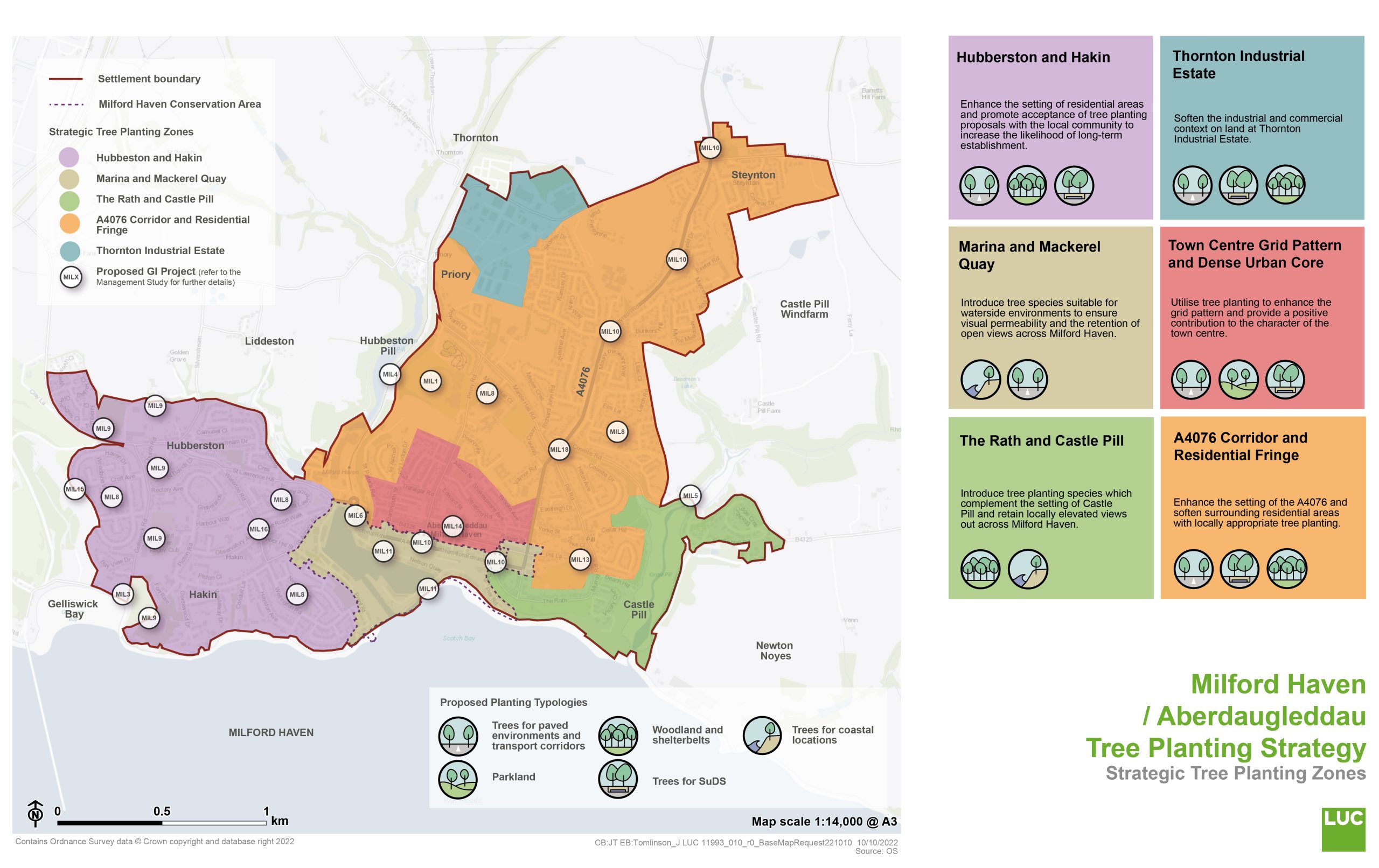
Zones and Sub-Principles
3.8 Land encompassed within Milford Haven Conservation Area includes the spaces between buildings and existing trees within the designation. PCC should therefore be contacted prior to the commencement of works on existing trees subject to a Tree Preservation Order (TPO) or those located within the boundary of Milford Haven Conservation Area.
Hubberston and Hakin
- Prioritise tree planting in areas with the least site constraints, such as larger areas of amenity grassland and verges, including areas with minimal recreational value due to slope / small size etc.
- Implement infill planting on streets with existing trees and where there are gaps, to strengthen existing tree corridors, which are small and fragmented.
- Incorporate tree planting across housing estates, integrating well-spaced parkland trees where space allows. Ensure sightlines are maintained for safety. Avoid creating areas of dense planting that may encourage antisocial behaviour, prioritising well-spaced high canopy trees, or narrow fastigiate species. Consult with, and engage, nearby residents throughout the process to increase the likelihood of long-term success. Ensure sufficient space between tree planting and residential dwellings to maintain views and access to light.
- Avoid proposals that conflict with private vehicular access points on residential streets.
- Tree planting proposals should avoid obstruction of highways and Public Rights of Way (PRoW) within the residential context.
- Enhance tree canopy cover within parks and open spaces. Prioritise planting of large canopy trees where space permits.
Thornton industrial estate
- Utilise tree planting to screen and soften industrial and commercial areas.
- Ensure that proposed tree planting complements the scale of existing built form. Where space permits, the potential exists to accommodate large trees within the industrial and commercial setting.
Marina and Mackerel Quay
- Integrate additional tree planting at the Marina and Quay with suitable species to create areas with shelter, whilst also maintaining visual permeability and views out to the sea. Consider the incorporation of additional trees when renovating existing planted areas.
- Ensure landscape management and future tree planting maintains views to the coast from elevated areas (e.g. key viewpoints from Hamilton Terrace).
- Use trees to mark and define different zones leading to the Marina and Quay, e.g. from entrances to the waterfront from cycle routes, Nelson Quay and leading down from Victoria Road.
- Consider integrating trees to break up the expansive car park area, ensuring the location does not interfere with existing uses. Integrate trees in small clusters to create a microclimate to improve growing conditions, and allow the incorporation of shared growing pits / rooting space.
- Use tree planting in hard landscape to enhance the setting of local facilities and restaurants, and screen detracting features such as the car park on Nelson Quay.
Town Centre grid pattern and dense urban core
- Extend and link up existing street tree planting at key centres (i.e. Charles Street) to create green routes and enhance the streetscape. Ensure tree planting compliments and does not detract from the distinctive grid pattern of the urban area. Incorporate trees nearby wider junctions and to mark entrances to the main shopping areas, using trees with a narrow form where necessary to maintain sightlines.
- Utilise tree planting to soften larger areas of hard landscape such as car parking areas (e.g. Robert Street). And other visually detracting features.
- Reconfigure on street parking where the opportunity arises to provide additional space for tree pits and width for tree growth.
The Rath and Castle Pill
- Sensitively incorporate additional low density tree planting or small groups of trees on grassland at The Rath. Ensure tree planting is located to maintain visual permeability to the coast from residential areas, seating areas and other viewpoints.
- Trees should be located lower down on sloped areas, with particular consideration given to eventual height and form. Particular attention should be given to selecting species that can withstand the exposure, taking note of species growing nearby.
- Buffer and expand existing woodland at Castle Pill / Deadman’s Lake and seek opportunities to enhance woodland edge treatments on adjacent agricultural land.
A4076 Corridor and Residential Fridge
- Use tree planting to buffer and screen busy route corridors, utilising roadside verges for avenues or small groups of trees where appropriate.
- Use ornamental tree species to mark key gateways and entrances towards Milford Haven.
- Strengthen links to larger areas of woodland adjacent to Deadman’s Lake, incorporating additional planting at adjacent amenity green space (e.g. Steynton Road / Mount Pleasant Way)
- Utilise tree planting to enhance the setting of residential areas, creating tree-lined streets where possible. Sufficient consideration should be given to species selection, ultimate canopy size and maintenance requirements to promote long-term establishment and reduce interference with buildings and services (e.g. telegraph lines / lighting columns).
- Prioritise tree planting in areas with the least site constraints, such as larger areas of amenity grassland and verges, including areas with minimal recreational value due to slope / small size etc.
- Avoid proposals which conflict with private vehicular access points on residential streets.
- Tree planting proposals should avoid obstruction of highways and Public Rights of Way (PRoW) within the residential context.
- Enhance the character of local open spaces and sport facilities with boundary trees, incorporating larger canopy parkland trees where space allows. Ensure sightlines are maintained to provide a sense of safety and security.
Narberth tree planting zones and sub-principles
3.9 Tree Planting Zones and Sub-Principles for Narberth are shown on the map and below. They include:
- Narberth Town Centre
- Utilise tree planting to soften the existing town centre street scene and frame townscape vistas.
- Narberth Residential Fringe
- Enhance the setting of residential areas and promote acceptance of tree planting proposals with the local community to increase the likelihood of long-term establishment.
Figure 3.4: Narberth Strategic Tree Planting Zones
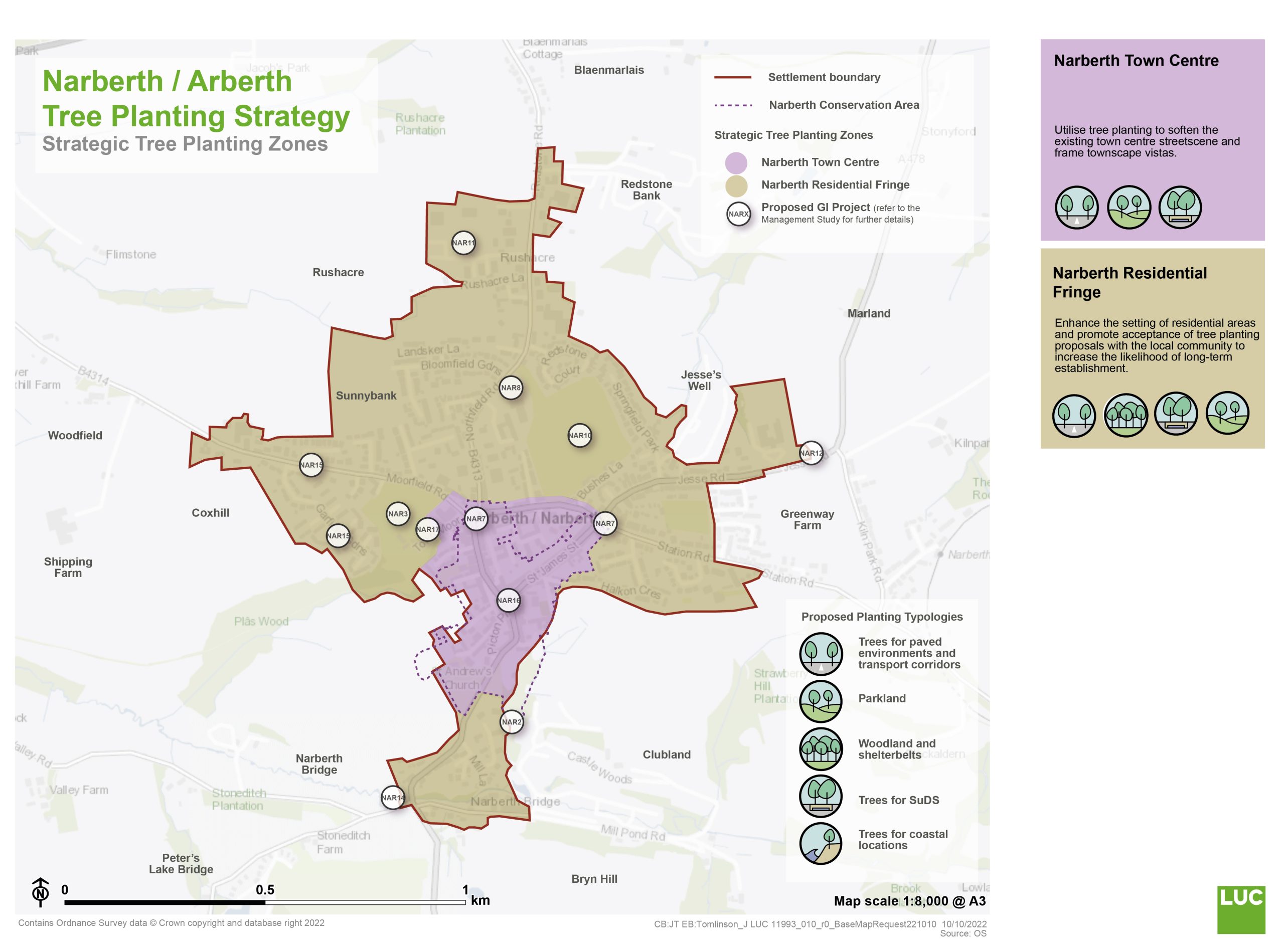
Zones and Sub-Principles
3.10 Land encompassed within Narberth Conservation Area includes the spaces between buildings and existing trees within the designation. PCC should therefore be contacted prior to the commencement of works on existing trees subject to a Tree Preservation Order (TPO) or those located within the boundary of Narberth Conservation Area.
Narberth Town Centre
- Ensure tree planting complements and does not detract from the distinctive townscape character.
- Tree planting opportunities within public areas in the town centre are highly constrained. Trees may be best placed at key entrances, fringes and wider junctions, utilising narrow form trees to maintain sightlines where needed.
- Where space allows, use ornamental tree species to demarcate key gateways and entrances towards Narberth town centre (such as the A478 / B4314 Junction).
- Utilise tree planting to soften hard landscape areas and create a sense of arrival at key visitor hubs (such as Townsmoor Car Park and route towards the town centre).
- Where trees are removed or lost, the replacement of appropriately located trees should be a priority within the town centre.
Narberth Residential Fringe
- Seek opportunities to deliver tree planting adjacent to water courses and ditches on the fringes of the urban area. This may be best delivered as wide shelterbelts and woodland corridors that strengthen existing field patterns.
- Enhance the character of local open spaces and sport facilities with boundary trees, seeking opportunities to plant larger canopy parkland trees as a priority (such as at Townsmoor Park). Ensure sightlines are maintained to provide a sense of safety and security.
- Utilise tree planting to enhance the setting of residential areas, creating tree lined streets where possible. Sufficient consideration should be given to species selection, ultimate canopy size and maintenance requirements to promote long-term establishment and reduce interference with buildings and services (e.g. telegraph lines / lighting columns).
- Prioritise tree planting in areas with the least site constraints, such as larger areas of amenity grassland and verges. This includes areas with minimal recreational value due to small size (such as some of the wider roadside verge areas along Cox Hill).
- Avoid proposals which conflict with private vehicular access points on residential streets.
- Tree planting proposals should avoid obstruction of highways and Public Rights of Way (PRoW) within the residential context.
Newport tree planting zones and sub-principles
3.11 Tree Planting Zones and Sub-Principles for Newport are shown on the map and below. They include:
- A487 Corridor and Town Centre
- Utilise tree planting to soften the existing town centre street scene and frame townscape vistas along the A487.
- Newport residential Fringe and Parrog Road Corridor
- Enhance the settings of residential areas and promote acceptance if tree planting proposals with the local community to increase the likelihood of long-term establishment.
Figure 3.5: Newport Strategic Tree Planting Zones
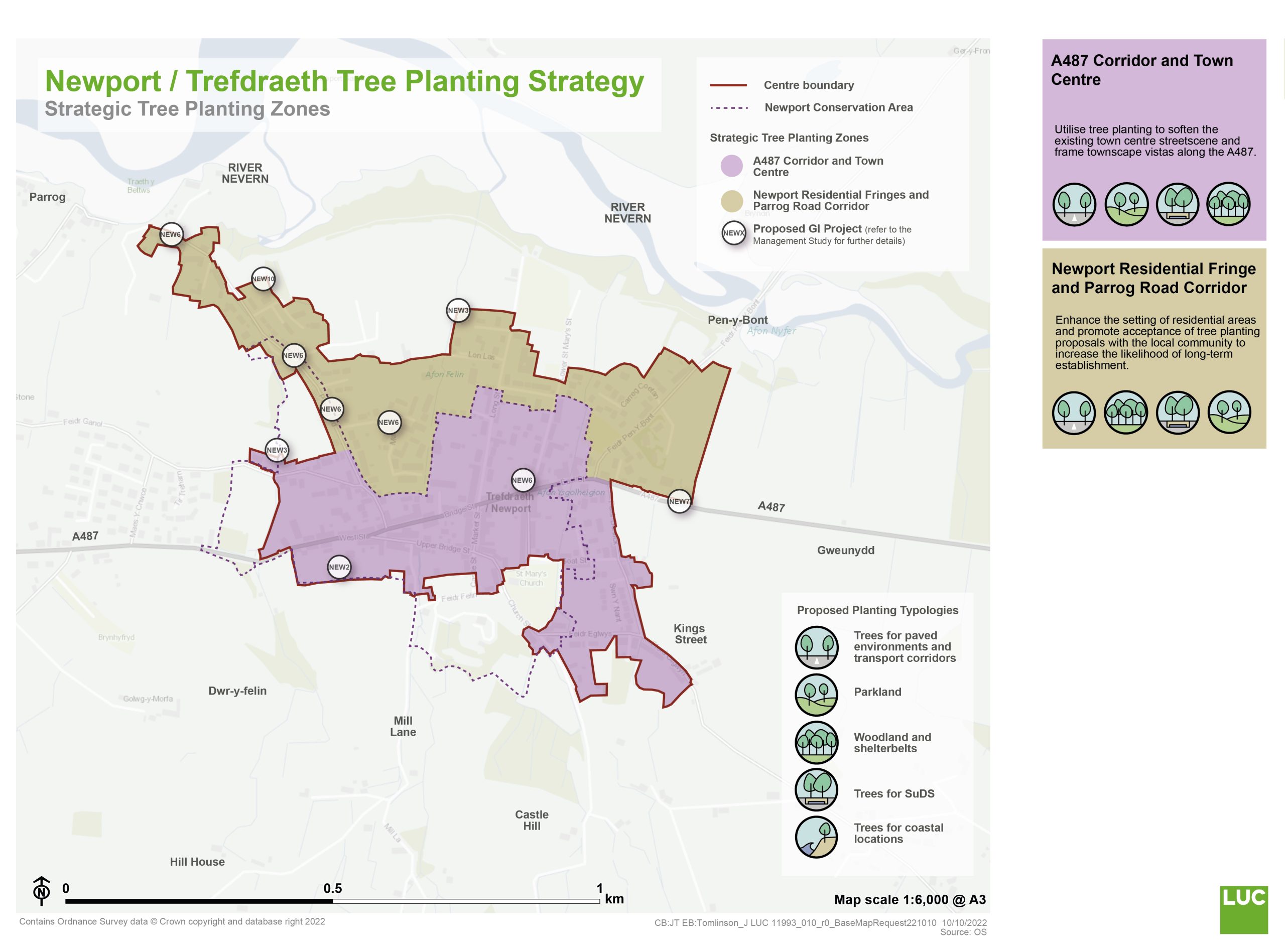
Zones and Sub-Principles
3.12 Land encompassed within Newport conservation area includes the spaces between buildings and existing trees within the designation. Pembrokeshire County council (PCC) should therefore be contacted prior to the commencement of works on existing trees subject to a Tree Preservation Order (TPO) or those located within the boundary of Newport conservation area.
3.13 Newport is located within the boundary of Pembrokeshire Coast National Park (PCNP). The development of detailed plans for future tree and woodland planting should take account of PCNP Tree and Woodland Guidance. Detailed assessment of ‘urban’ Landscape Character Areas (such as Newport) is not included in the PCNP guidance, due to the limited opportunity for new woodland planting in these areas. However, the generic guidance within this document would still apply.
A487 Corridor and Town Center
- Use ornamental tree species to demarcate key gateways and entrances towards Newport.
- Strengthen links to existing woodland along the settlement edge, such as areas of woodland nearby Newport Castle. This may include strengthening existing field boundaries through the development of shelter belts and woodland corridors.
- Tree planting opportunities within public areas in the town centre are highly constrained. Trees may be best placed at key entrances, fringes and wider junctions, utilising narrow form trees to maintain sightlines where needed.
- Where trees are removed or lost, the replacement of appropriately located trees should be a priority. Where space allows, seek opportunities to incorporate additional trees at key hubs of activity (e.g. near Long Street Car Park).
- Promote the planting of small trees within residential gardens, focussing on areas where there is the least opportunity for planting within the public realm.
Newport Residential Fringes and Parrog Road Corridor
- Utilise tree planting to enhance the setting of residential areas, creating tree lined streets where possible. Sufficient consideration should be given to species selection, ultimate canopy size and maintenance requirements to promote long-term establishment and reduce interference with buildings and services (e.g. telegraph lines / lighting columns).
- Prioritise tree planting in areas with the least site constraints, such as larger areas of amenity grassland and verges. This includes areas with minimal recreational value due to small size (such as some of the wider roadside verge areas along Parrog Road).
- Avoid proposals which conflict with private vehicular access points on residential streets.
- Tree planting proposals should avoid obstruction of highways and Public Rights of Way (PRoW) within the residential context.
- Enhance the character of local open spaces and sport facilities with boundary trees, incorporating larger canopy parkland trees where space allows (such as open space adjacent to Newport Skate Park). Ensure sightlines are maintained to provide a sense of safety and security.
- Use tree planting to soften hard landscape areas and features that may detract from enjoyment of the wider landscape. Such car parking areas (e.g. Parrog Road Car Park). New tree planting should ensure key views to the river and coast are maintained.
Neyland tree planting zones and sub-principles
3.14 Tree Planting Zones and Sub-Principles for Newport are shown on the map and below. They include:
- The Promenade, Brunel Quay and Marina
- Introduce tree species suitable for coastal environments to ensure visual permeability and the retention of open views across Milford Haven
- Neyland Residential Fringe
- Enhance the setting of residential areas and promote acceptance of tree planting and promote acceptance of tree planting proposals with the local community to increase the likelihood of long term establishment
- Great Honeyborough
- Enhance the setting of Honeyborough Green and its surrounding context. Ensure consideration is given to species selection, including ultimate canopy size.
- Honeyborough Business Park
- Soften the industrial and commercial context on land at Honeyborough business Park
Figure 3.6: Neyland Strategic Tree Planting Zones
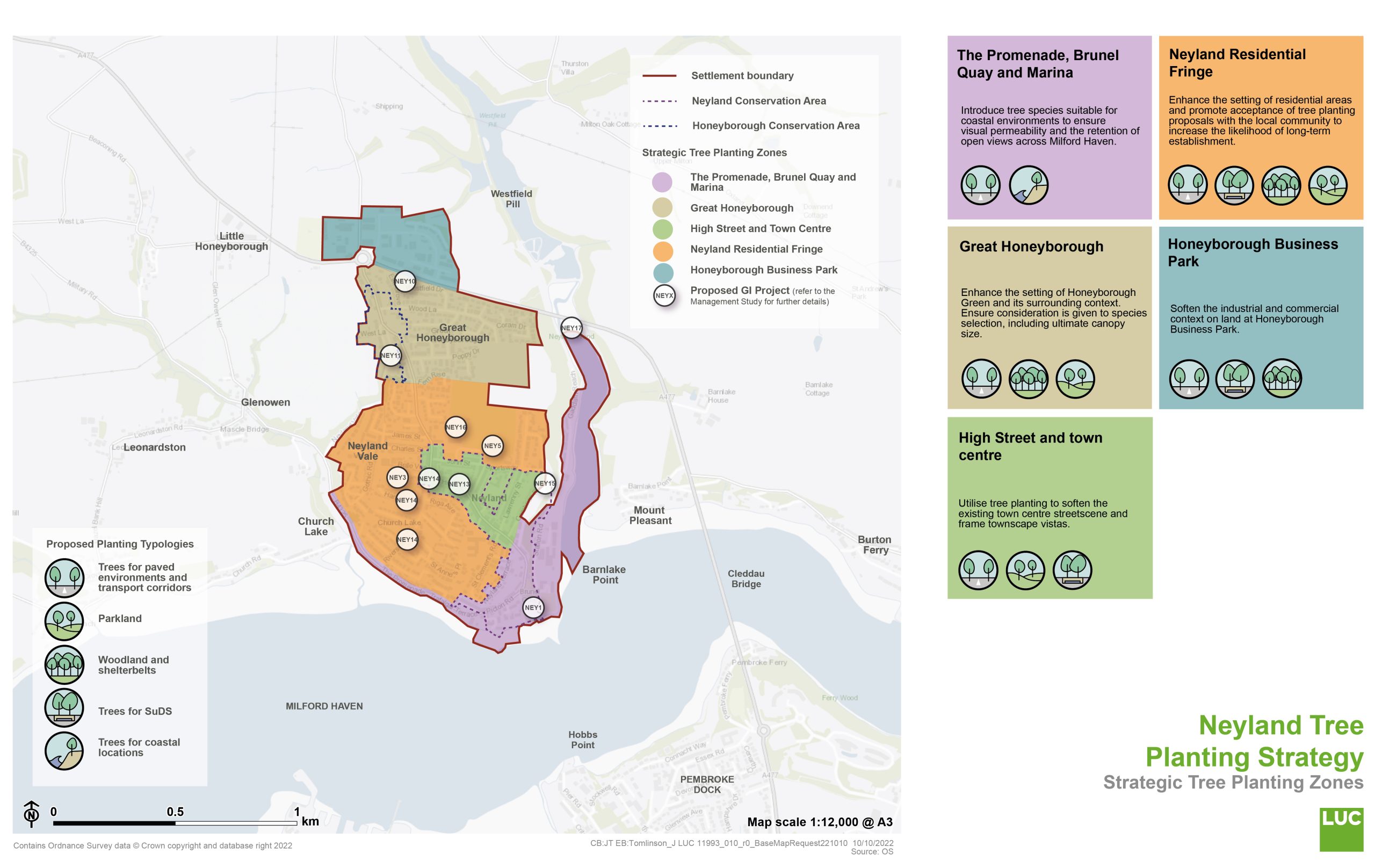
Zones and Sub-Principles
3.15 Land encompassed within Neyland Conservation Area and Honeyborough Conservation Area includes the spaces between buildings and existing trees within the designated areas. Pembrokeshire County Council (PCC) should therefore be contacted prior to the commencement of works on existing trees subject to a Tree Preservation Order (TPO) or those located within the boundary of either conservation area.
The Promenade, Brunel Quay and Marina
- Consider integrating trees to soften the expansive car park areas and enhance the setting of key arrival points, whilst ensuring the location of new trees does not interfere with existing uses. Integrate trees in small clusters to create a microclimate to improve growing conditions and allow incorporation of shared growing pits / rooting space in hard landscape.
- Ensure landscape management and future tree planting maintains key views, such as from the promenade and seating areas along Station Road. This should be achieved utilising well-spaced trees with clear stems / high canopies. Widely spaced, small groups of trees may also be appropriate at the edges of small areas of green space set back from the seafront.
- Utilise tree planting to soften and screen industrial areas and green routes along Station Road and Gaddam Reach.
Great Honeyborough
- Implement infill planting and new planting of flowering trees along Honeyborough Road, enhancing a key route towards the centre of Neyland.
- Maintain or increase tree canopy cover at Honeyborough Green. Ensure planting density and tree form / size, maintains the village green character.
- Protect and enhance belts for trees to act as a buffer and screen for the A477 and adjacent industrial area.
High Street and Town Centre
- Ensure tree planting complements and does not detract from the distinctive townscape character.
- Ensure views from key routes (such as the High Street) are not obscured by inappropriate tree planting. Trees may be best placed at key entrances, fringes and wider junctions, utilising narrow form trees to maintain sightlines where needed. Maintain long range views from the edge of the area from elevated viewpoints (such as at Cambrian Road).
- Use small specimen trees to soften hard landscape areas and create a sense of arrival Atkey visitor hubs (such as High Street Car Park).
- Protect, and if appropriate increase, canopy cover at incidental areas of green space leading off the High Street to maintain and enhance townscape character (e.g. at Windsor Gardens, Lawrenny Street, Railway Terrace).
Neyland Residential Fringe
- Utilise tree planting to enhance the setting of residential areas, creating tree lined streets where possible. Sufficient consideration should be given to species selection, ultimate canopy size and maintenance requirements to promote long-term establishment and reduce interference with buildings and services (e.g. telegraph lines / lighting columns).
- Avoid proposals which conflict with private vehicular access points on residential streets.
- Tree planting proposals should avoid obstruction of highways and Public Rights of Way(PRoW) within the residential context.
- Prioritise tree planting in areas with the least site constraints, such as larger areas of amenity grassland and wide verges. This includes areas with minimal recreational value due to small size.
- Where possible, link up and extend existing, fragmented rows of street trees within grass verges (e.g. along Riverside Avenue).
- Enhance the character of local open spaces, sport and community facilities with boundary trees, seeking opportunities to plant larger canopy parkland trees as a priority (such Askeland Community Hub). Ensure sightlines are maintained to provide a sense of safety and security.
Honeyborough Business Park
- Increase tree cover to soften the views towards industrial development. This may include wider verges at key entrances (such as the A477 roundabout).
- Ensure greening of streets through tree planting, especially where any upgrades of access roads or car parks is undertaken. Utilise tree planting to screen buildings to nearby residential areas and the wider landscape. Ensure new tree planting is required as part of future industrial development.
Pembroke tree planting zones and sub-principles
3.16 Tree Planting Zones and Sub-Principles for Pembroke are shown on the map and below. They include:
- Pembroke Mill Pond
- Improve the setting and the public’s experience of the Mill Pond through the retention and enhancement of tree planting to the northern edge. Ensure that proposals to not result in detrimental impacts on the burgage boundary walls to the south.
- Pembroke Residential Fringe
- Enhance the setting of residential areas and promote acceptance of tree planting proposals with the local community to increase the likelihood of long term establishment.
- Castle and Town Centre Approach
- Enhance prominent route corridors on the approach and exit of Pembroke and frame townscape vistas.
- The Commons
- Utilise tree planting to enhance the historic townscape setting, whilst retaining the open character of the Commons. Proposals should also consider the site’s role in flood alleviation and opportunities for increased biodiversity.
Figure 3.7: Pembroke Strategic Tree Planting Zones
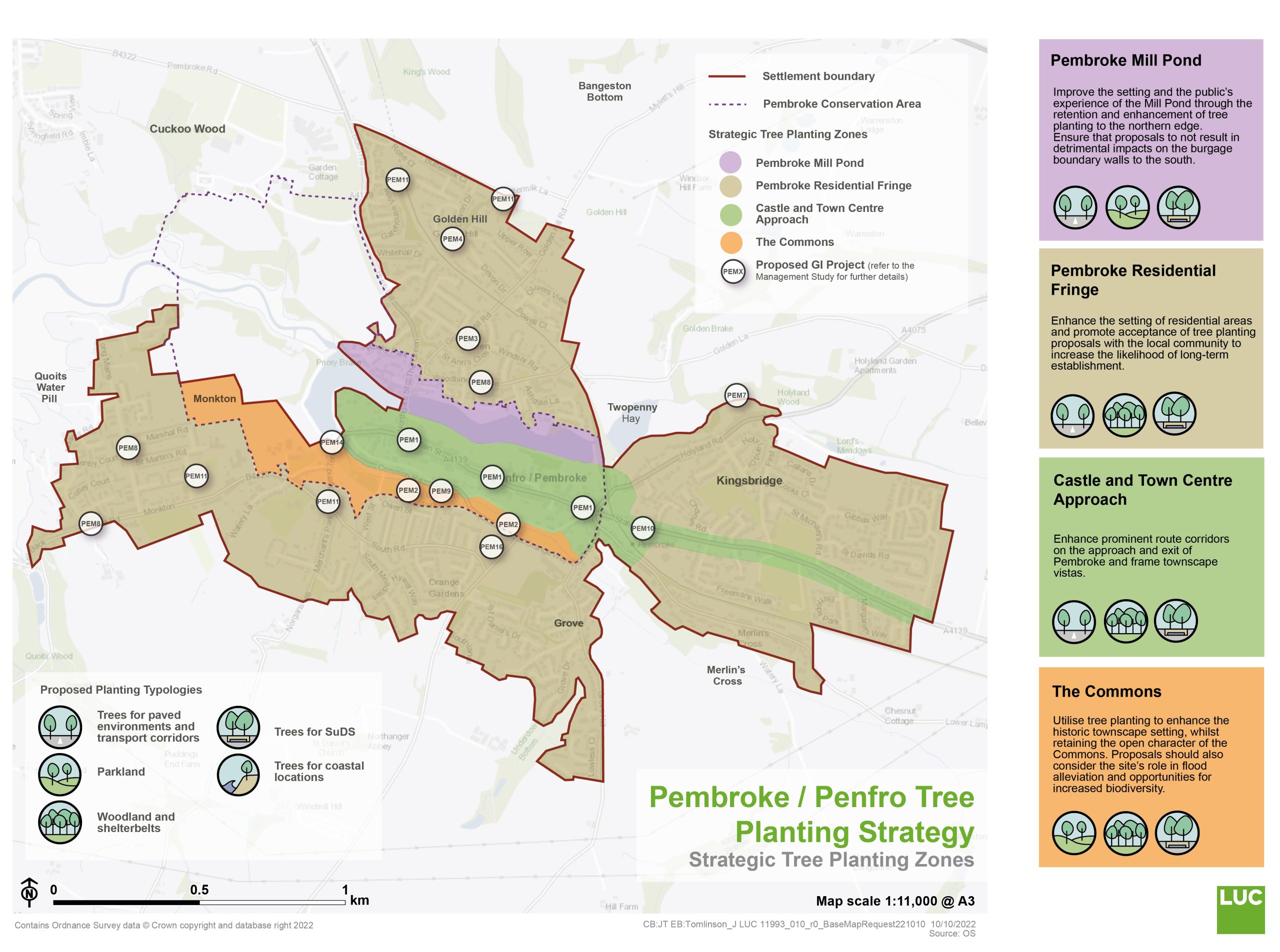
Zones and Sub-Principles
3.17 Land encompassed within Pembroke Conservation Area includes the spaces between buildings and existing trees within the designation. Pembrokeshire County Council (PCC) should therefore be contacted prior to the commencement of works on existing trees subject to a Tree Preservation Order (TPO) or those located within the boundary of Pembroke Conservation Area.
Pembroke Mill Pond
- Maintain and enhance tree cover along the northern edge of the Mill Pond as a key environmental asset, habitat and visual amenity.
- Tree planting in close proximity to the burgage wall will generally be inappropriate. Views and structural integrity of this heritage feature should not be negatively impacted by additional tree planting. Any tree planting proposals will need to be developed in consultation with relevant statutory consultees.
Pembroke Residential Fringe
- Utilise tree planting to frame views and vistas across the varied roofscape of Pembroke town centre. Consideration should be given to ultimate tree canopy size when specifying species.
- Sufficient consideration should be given to species selection and maintenance requirements to promote long-term establishment and reduce interference with buildings and services (e.g. telegraph lines / lighting columns).
- Prioritise tree planting in areas with the least site constraints, such as larger areas of amenity grassland and verges, including areas with minimal recreational value due to slope / small size etc. (e.g. Long Mains & Bush Hill).
- Avoid proposals which conflict with private vehicular access points on residential streets. Tree planting proposals should avoid obstruction of highways and Public Rights of Way (PRoW) within the residential context.
Castle and Town Centre Approach
- Tree planting proposals should have regard to existing building lines and the orientation of existing development along Main Street. This includes responding to the pattern of the streetscape in terms of bays, ‘nodes’ and courtyard gardens which break up the facade.
- Utilise tree planting to minimise the visual impact of parked cars on the streetscape as well as the landscape setting of historic streets and buildings.
- Use tree planting to mark routes and entrances to Main Street. Ensure new planting does not impede with the range of uses of the area, including events.
- Utilise tree planting to soften larger areas of hard landscape and areas of car parking (e.g. near West Street / Common Road). Incorporate engineered Sustainable Drainage Systems (SuDS) as part of tree pit design to maximise water storage capacity and reduce surface water run-off to nearby water courses.
The Commons
- Ensure species selection continues to enhance the diversity of trees on the Commons, a key element that contributes to the special interest and character of the Pembroke Conservation Area.
- Protect and maintain the existing population of trees. Undertake a planned programme of planting to ensure a stock of young and developing trees. Implement infill planting to enhance existing rows and avenues of trees.
- Introduce small, ornamental trees at some of the key entrances as markers and to improve the sense of arrival.
- Use tree planting in the east of The Commons to partially screen views towards more recent development to help maintain the historic character of the area.
Pembroke Dock tree planting zones and sub-principles
3.18 Tree Planting Zones and Sub-Principles for Pembroke Dock are shown on the map and below. They include:
- Historic Grid Pattern
- Utilise tree planting to enhance the grid pattern as a defining characteristic of the area and provide a positive contribution to the character of Pembroke Dock Conservation Area.
- Cleddau Bridge Business Park and Waterloo Industrial Estate
- Soften the industrial and commercial context on land to the east of the A477 Waterloo Road
- Royal Dockyard and Hobbs Point
- Promote the military and maritime history of the town, whilst ensuring that tree planting proposals do not impact negatively on the setting of historical significant assets.
- Llanreath and Llanion Hill
- Introduce tree planting species which are suitable for coastal environments to ensure visual permeability and the retention of locally elevated views out toward Milford Haven.
- Pennar and Llanion Residential Fringe
- Enhance the setting of residential areas and promote acceptance of tree planting proposals with the local community to increase the likelihood of long term establishment
- Arterial Road Corridors and Cleddau Bridge Approach
- Enhance prominent route corridors on the approach and exit of Pembroke Dock and frame townscape vistas.
Figure 3.8: Pembroke Dock Strategic Tree Planting Zones
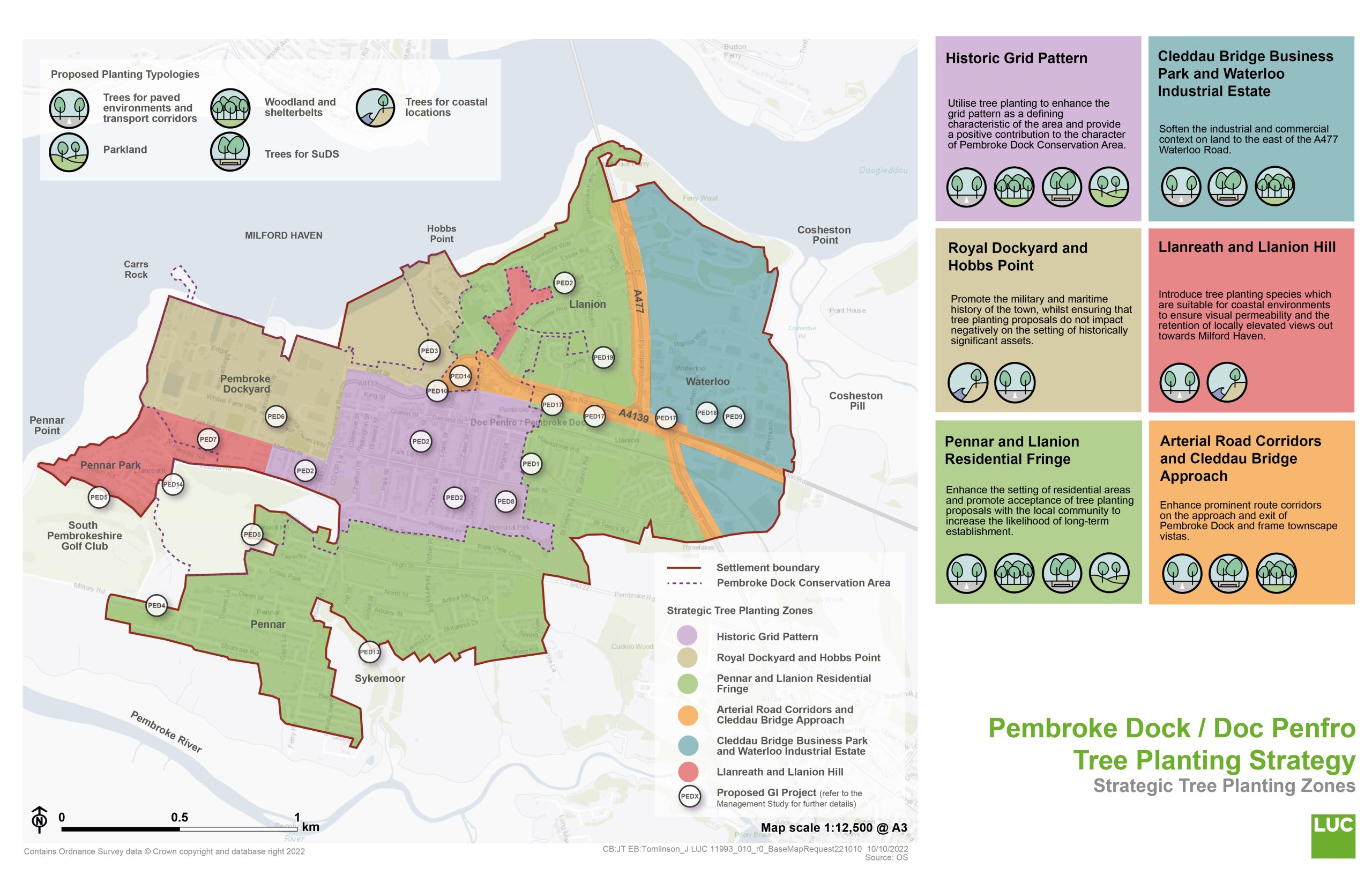
Zones and Sub-Principles
3.19 Land encompassed within Pembroke Dock Conservation Area includes the spaces between buildings and existing trees within the designation. Pembrokeshire County Council (PCC) should therefore be contacted prior to the commencement of works on existing trees subject to a Tree Preservation Order (TPO) or those located within the boundary of Pembroke Dock Conservation Area.
Historic Grid Pattern Town
- Ensure that tree planting proposals enhance the setting of the distinctive historic grid pattern and do not result in detrimental impacts on heritage assets. All planting proposals should be prepared in conjunction with both the Historic Building Conservation Officer and Landscape Officer at PCC.
- Whilst trees are not a particular characteristic of the grid pattern area, opportunities should be sought for tree planting to provide a positive contribution to the townscape character and appearance. Consideration should be given to the introduction of a hierarchy of tree planting to preserve and reinforce the distinctive grid pattern. Proposed categories within the hierarchy are outlined below.
- Street where a replenishment programme is required for an existing tree avenue (either a long-term replacement strategy for mature specimens or as a response to ash dieback);
- Statement street where tree avenues could be accommodated (within an existing central reservation or within wide pavements);
- Street where tree planting could be included within ‘nodes’ through the partial reconfiguration of existing parking etc; and
- Street which is narrow and heavily constrained where tree planting would be limited to gateway specimens (to frame a vista or with the aim of retaining key views).
- Tree planting proposals should have regard to existing building lines and the orientation of existing development. This includes responding to the pattern of the streetscape in terms of bays and ‘nodes’ which break up the façade.
- Utilise tree planting to minimise the visual impact of parked cars on the streetscape as well as the landscape setting of historic streets and buildings.
- Consider ultimate tree canopy size in order to maintain key views and vistas towards key buildings within Pembroke Dock Conservation Area.
- Promote variation in the age structure of tree planting within Memorial Park, particularly along the boundary and as part of the central axial point, as a proactive mechanism of long-term tree management.
- Promote tree planting (using appropriate species) within rear gardens to make an increased contribution to urban greening within the grid pattern streetscape.
Royal Dockyard and Hobbs Point
- Utilise tree planting to enhance the setting of the Pembroke Dock Conservation Area and do not result in any detrimental impacts on heritage assets. All planting proposals should be prepared in conjunction with both the Historic Building Conservation Officer and Landscape Officer at PCC.
- Enhance the townscape setting and complement the existing avenues of mature trees located on Meyrick Owen Way. Utilise tree planting to conserve the framed vista from the former Royal Dockyard entrance to the Pembroke Dock Heritage Centre.
- Soften the hard and soft streetscape of arterial routes such as the A4139 Western Way.
- Explore opportunities to increase the network of street trees on Fort Road in order to delineate the route as a key corridor leading to West Martello Tower and the waterfront.
- Diversify the structure of the existing woodland on Carriage Drive / The Terrace to allow light to penetrate the ground flora and support pollinator species.
Pennar and Llanion
- Utilise tree planting to enhance the setting of residential streets and complement the topography, ensuring sufficient consideration is given to species selection, ultimate canopy size and maintenance requirements to promote long-term establishment.
- Avoid proposals which conflict with private vehicular access points on residential streets;
- Tree planting proposals should avoid obstruction of highways and Public Rights of Way (PRoW) within the residential context.
- Promote community ownership of proposed tree planting to increase the likelihood of long- term establishment.
Arterial Road Corridors and Cleddau Bridge Approach
- Ensure high-crowned species are specified to ensure the availability of appropriate visibility splays and pedestrian access within the existing thoroughfares.
- Where appropriate, consider the use of large species with wide canopy coverage for use in the provision of shade. Avoid fruit bearing trees in areas of proposed seating provision or pedestrian footways.
Cleddau Bridge Business Park and Waterloo Industrial Estate
- Ensure that proposed tree planting complements the scale of existing built form. Where space permits, the potential exists to accommodate large trees within the industrial and commercial setting.
Llanreath and Llanion Hill
- Retain existing vistas by avoiding interruption of sea views from bordering residential properties.
- Ensure consideration is given to species selection (including ultimate canopy size and maintenance requirements) and the inclusion of salt tolerant species due to the proximity of the waterfront.
- Avoid proposals that conflict with private vehicular access points on residential streets.
- Tree planting proposals should avoid obstruction of highways and Public Rights of Way (PRoW) within the residential context.
Saundersfoot tree planting zones and sub-principles
3.20 Tree Planting Zones and Sub-Principles for Saundersfoot are shown on the map and below. They include:
- Saundersfoot Harbour and Sea front
- Introduce tree species suitable for waterside environments to ensure visual permeability and the retention of open views across Saundersfoot Bay
- High Street and Settlement Core
- Utilise tree planting to soften the existing town centre streetscene and frame townscape vistas.
- Saundersfoot Residential
- Enhance the setting of residential areas and promote acceptance of tree planting proposals with the local community to increase the likelihood of long term establishment.
Figure 3.9: Saundersfoot Strategic Tree Planting Zones
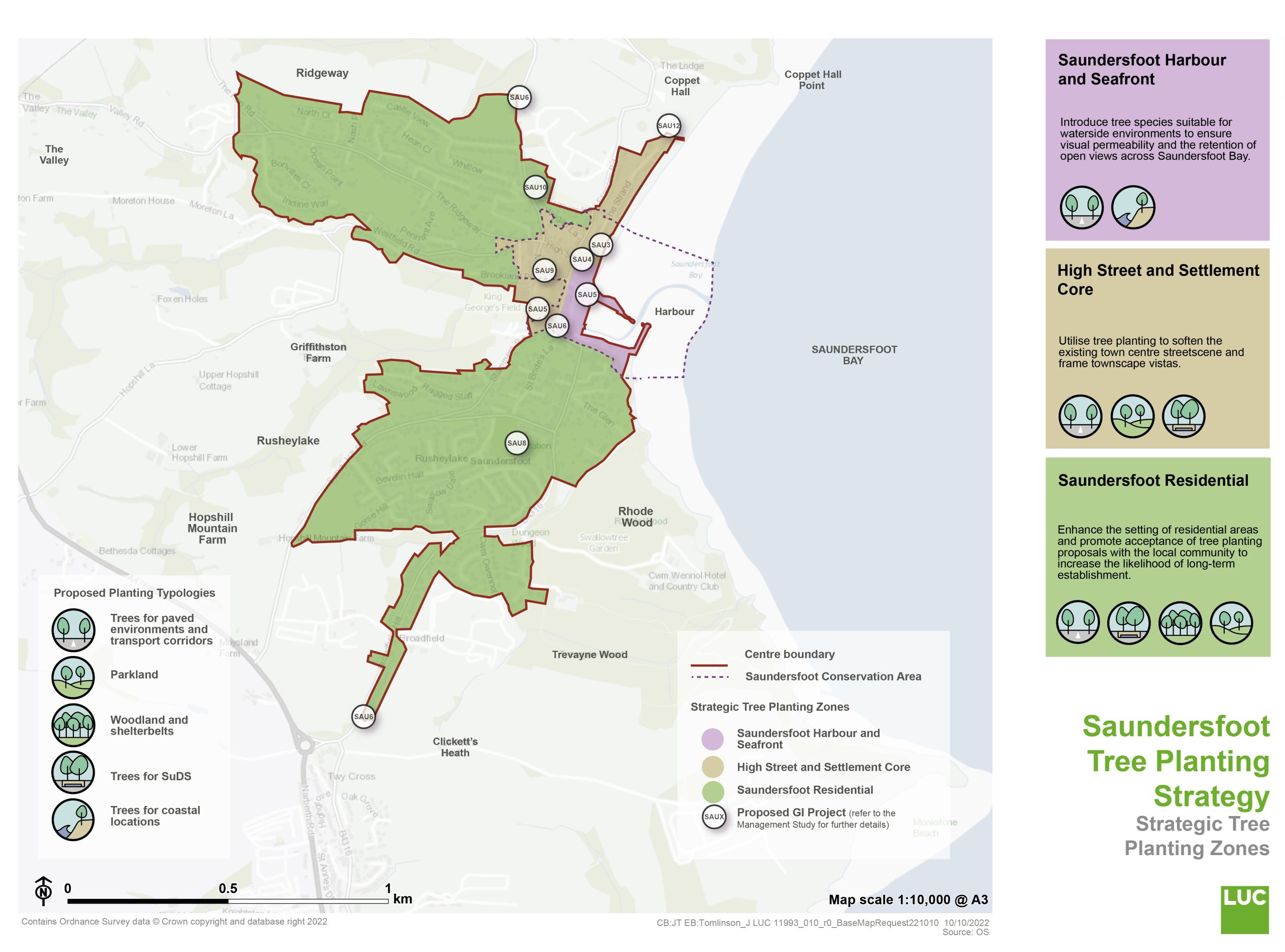
Zones and Sub-Principles
3.21 Land encompassed within Saundersfoot Conservation Area includes the spaces between buildings and existing trees within the designation. Pembrokeshire County Council (PCC) should therefore be contacted prior to the commencement of works on existing trees subject to a Tree Preservation Order (TPO) or those located within the boundary of Saundersfoot Conservation Area
3.22 Saundersfoot is located within the boundary of Pembrokeshire Coast National Park (PCNP). The development of detailed plans for future tree and woodland planting should take account of PCNP Tree and Woodland Guidance.
Saundersfoot Harbour and Seafront
- Integrate additional tree planting at the harbour and seafront with suitable species to create areas with a sense of shelter, whilst also maintaining visual permeability and views out to the sea. Consider the incorporation of additional trees when renovating existing planted areas.
- Use trees to mark and define different zones leading to the harbour, such as the near the interface between the harbour and The Strand.
- Consider integrating trees to break up the expansive car park area, ensuring the location does not interfere with existing uses. Integrate trees in small clusters to create a microclimate to improve growing conditions and allow the incorporation of shared growing pits / rooting space.
High Street and Settlement Core
- Ensure that tree planting proposals enhance the setting of the compact core and do not result in detrimental impacts on heritage assets or the settlement’s historic fabric. All planting proposals should be prepared in conjunction with PCNPA.
- Review tree management practices to ensure the availability of views and vistas towards the coast and sheltered valley which forms a rural backdrop.
- Opportunities should be sought for tree planting to provide a positive contribution to townscape character and the setting of Saundersfoot Conservation Area.
- Strengthen links between the settlement core and surrounding woodland by enhancing and linking field boundaries and shelter belts to the north. Planting should also be considered alongside nearby watercourses to reduce surface water run-off and improve water quality.
- Enhance routes into and through the settlement core, seeking opportunities to incorporate tree planting within hard landscape areas, including the B4316, and Brooklands Close car park. Integrate Sustainable Drainage Systems (SuDS) design as part of tree pits where possible.
Saundersfoot Residential
- Utilise tree planting to enhance the setting of residential streets and complement views in more elevated areas. Sufficient consideration should be given to species selection, ultimate canopy size and maintenance requirements to promote long-term establishment and reduce interference with buildings and services (e.g. telegraph lines / lighting columns).
- Avoid proposals that conflict with private vehicular access points on residential streets. Tree planting proposals should avoid obstruction of highways and Public Rights of Way (PRoW) within the residential context.
- Use tree planting to mark the approaches to Saundersfoot along prominent route corridors (e.g. B4316), utilising roadside verges for avenues or small groups of trees where possible. Promote community ownership of proposed tree planting to increase the likelihood of long- term establishment. Support community interest in pockets of urban woodland (e.g.
- Saundersfoot Plantation) to engage communities in the wider interest of tree care and management.
- Utilise tree planting at the fringes of residential areas to help screen tourism development, which often acts as a key detracting landscape feature.
- Strengthen field boundaries and shelterbelts, through gapping up and new tree planting, on the urban fringe to connect the urban forest to existing valley woodlands.
St Davids tree planting zones and sub-principles
3.23 Tree Planting Zones and Sub-Principles for St Davids are shown on the map and below. They include:
- Glasfryn Road Commercial
- Soften the commercial context on land at Glasfryn Road
- Visitor Centre and Hotel
- Utilise tree planting to enhance the sense of arrival into the city for both visitors and residents
- St Davids Residential Fringe
- Enhance the setting of residential areas and promote acceptance of tree planting proposals with the local community to increase the likelihood of long term establishment.
- St Davids City Centre
- Utilise tree planting to enhance the city’s dense medieval street pattern, whilst ensuring that tree planting proposals do not impact negatively on the setting of historically significant assets.
Figure 3.10: St Davids Strategic Tree Planting Zones
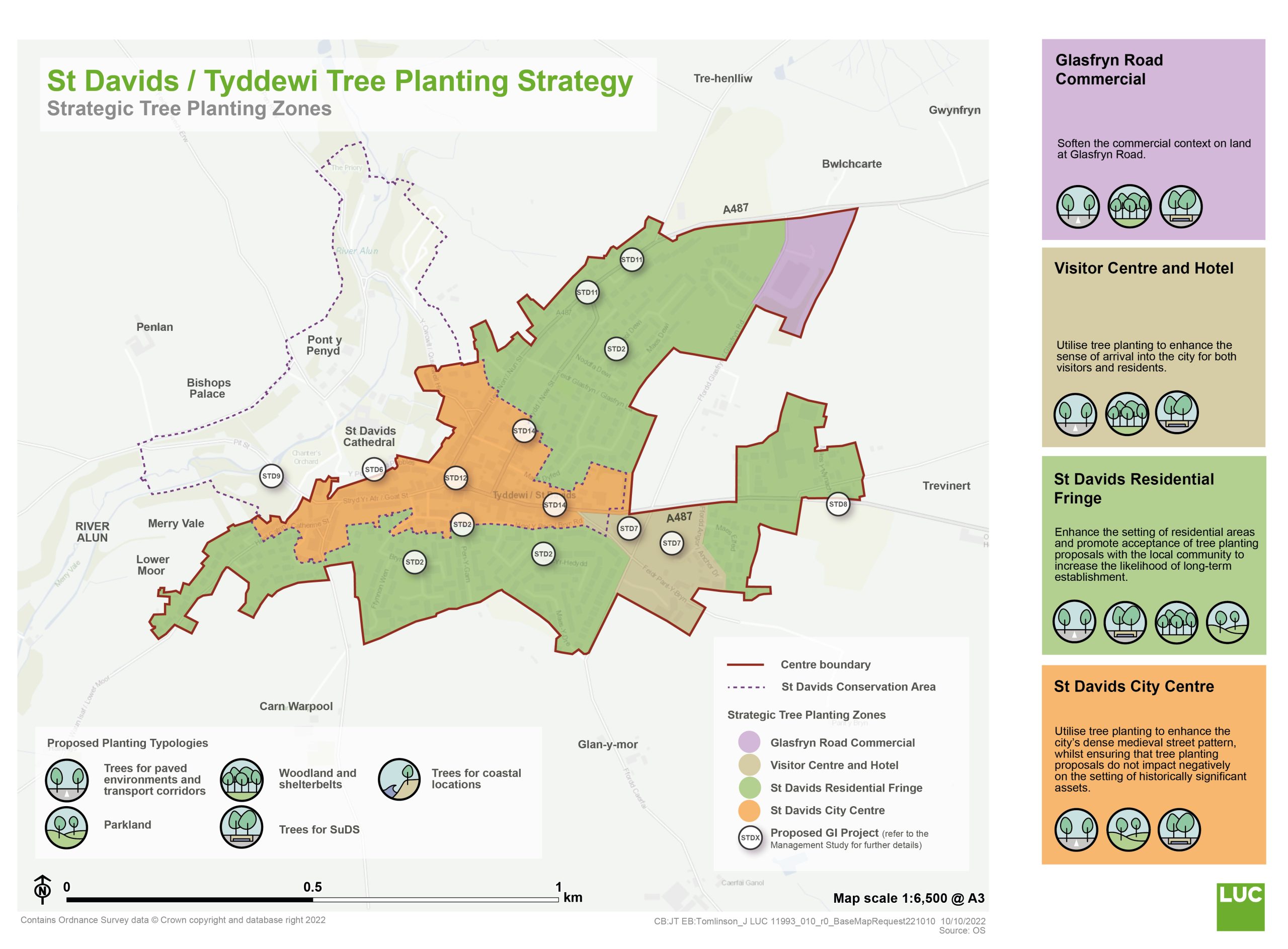
Zones and Sub-Principles
3.24 Land encompassed within St David’s Conservation Area includes the spaces between buildings and existing trees within the designation. Pembrokeshire County Council (PCC) should therefore be contacted prior to the commencement of works on existing trees subject to a Tree Preservation Order (TPO) or those located within the boundary of St David’s Conservation Area.
3.25 St Davids is within Pembrokeshire Coast National Park (PCNP). The development of detailed plans for future tree and woodland planting should take account of PCNP Tree and Woodland Guidance. Detailed assessment of ‘urban’ Landscape Character Areas (such as St Davids) is not included in the PCNP guidance, due to the limited opportunity for new woodland planting in these areas. However, the generic guidance within this document would still apply.
Glasfryn Road Commercial
- Utilise tree planting to screen and soften industrial and commercial areas
- Due to the open nature and expansive views of surrounding farmland, large scale woodland planting will likely be inappropriate. Screening and buffering of roads, industrial & commercial buildings should be through strengthening existing field boundaries and shelterbelts.
Visitor Centre and Hotel
- Maintain existing canopy cover and use additional tree planting to mark the arrival to St Davids and entrances to key hubs, where space allows.
- Enhance the sense of arrival and provide additional partial screening of the car park with well-spaced trees, whilst still maintaining an open feel.
St Davids Residential Fringe
- Utilise tree planting to enhance the setting of residential areas, creating tree lined streets where possible. Sufficient consideration should be given to species selection, ultimate canopy size and maintenance requirements to promote long-term establishment and reduce interference with buildings and services (e.g. telegraph lines / lighting columns).
- Avoid proposals that conflict with private vehicular access points on residential streets.
- Ensure sightlines are maintained for safety, avoid creating areas of dense planting that may encourage antisocial behaviour, prioritising well-spaced high canopy trees, or narrow fastigiate species.
- Prioritise tree planting in areas with the least site constraints, such as larger areas of amenity grassland and verges, including areas with minimal recreational value due to slope / small size etc.
- Use tree planting to buffer and screen residential areas from route corridors and mark the approach to St Davids (e.g. A487), utilising roadside verges for avenues or small groups of trees where appropriate. This may include incorporating groups of trees on wiser grass verges along Nun Street.
St David’s City Centre
- Ensure replacement planting of existing trees (if lost or removed) is an ongoing requirement to maintain and ideally increase canopy cover. Whilst there are relatively few trees within the built-up areas of the conservation area, there are several groups of deciduous trees that positively contribute to the streetscape.
- Many of the city centre streets are narrow, with minimal opportunity for additional street tree planting. Trees may be best placed at key entrances, fringes and wider junctions, utilising narrow form trees to maintain sightlines where needed.
Tenby tree planting zones and sub-principles
3.26 Tree Planting Zones and Sub-Principles for Tenby are shown on the map and below. They include:
- The Walled Town and Historic Centre
- Utilise tree planting to enhance the historic town centre, whilst ensuring the tree planting proposals do not impact negatively on the setting of historically significant assets.
- The Salterns Industrial and Commercial
- Soften the industrial and commercial context on land at Salterns Industrial Estate.
- The Esplanade and Harbour
- Introduce tree species suitable for waterside environments to ensure visual permeability and the retention of sea views.
- Tenby Residential Fringe
- Enhance the setting of residential areas and promote acceptance of tree planting proposals with the local community to increase the likelihood of long term establishment.
Figure 3.11: Tenby Strategic Tree Planting Zones
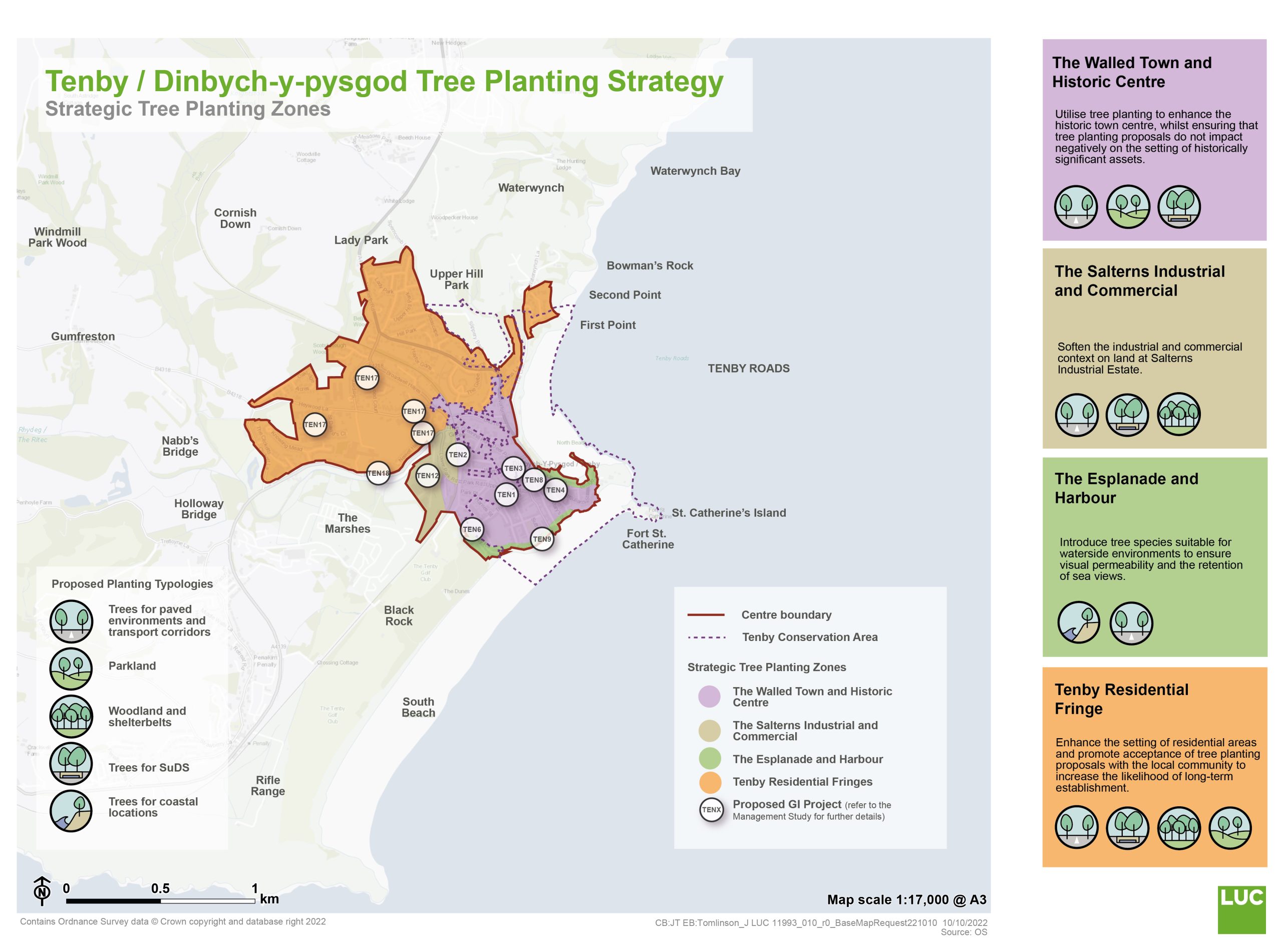
Zones and Sub-Principles
3.27 Land encompassed within Tenby Conservation Area includes the spaces between buildings and existing trees within the designated areas. Pembrokeshire County Council (PCC) should therefore be contacted prior to the commencement of works on existing trees subject to a Tree Preservation Order (TPO) or those located within the boundary of Tenby Conservation Area.
3.28 Tenby is located within the boundary of Pembrokeshire Coast National Park (PCNP). The development of detailed plans for future tree and woodland planting should take account of PCNP Tree and Woodland Guidance. Detailed assessment of ‘urban’ Landscape Character Areas (such as Tenby) is not included in the PCNP guidance, due to the limited opportunity for new woodland planting in these areas. However, the generic guidance within this document would still apply.
The Walled Town and Historic Centre
- Ensure tree planting complements and does not detract from the distinctive townscape character. Tree planting proposals should have regard to existing building lines and the orientation of existing development. This includes responding to the pattern of the streetscape in terms of bays and ‘nodes’ which break up the facade.
- Views towards and along the length of the town wall should be maintained, ensuring any new tree planting does not significantly impede views or conflict with heritage assets / underground archaeology.
- Utilise tree planting to minimise the visual impact of parked cars on the streetscape as well as the landscape setting of historic streets and buildings.
- Where opportunity arises and where appropriate, consider re-purposing small areas of on street parking to accommodate tree planting within hard landscape (e,g, wider sections along High Street & St Julian’s Street).
- Tree planting in many locations may be best placed at wider junctions and pedestrian areas, utilising narrow form trees to maintain sightlines where needed.
The Salterns Industrial and Commercial
- Increase tree cover to soften the views towards industrial development. This could include the boundaries of car parking areas (such as The Green Car Park).
- Maintain and increase canopy cover at The Green, protecting the site as a key green asset and helping to mitigate visually detracting features and commercial buildings.
- Ensure greening of streets through tree planting, especially where any upgrades of access roads or car parks is undertaken. Ensure new tree planting is required as part of future industrial development.
The Esplanade and Harbour
- Ensure landscape management and future tree planting maintains key views, such as from the promenade and seating areas along Battery Road. This should be achieved utilising well-spaced trees with clear stems / high canopies. Widely spaced, small groups of trees may also be appropriate at the edges of small areas of green space set back from the seafront.
- Utilise small scale tree planting to soften and filter the visual impact of features such as Seafront Car Park. Tree planting may be best located in small numbers to mark entrances and focussed around existing facilities such toilet blocks and near the skate park / play park.
- Integrate trees in small clusters to create a microclimate to improve growing conditions within exposed locations, and to allow the incorporation of shared growing pits / rooting space in hard landscape.
Tenby Residential Fringes
- Utilise tree planting to enhance the setting of residential areas, creating tree lined streets where possible. Sufficient consideration should be given to species selection, ultimate canopy size and maintenance requirements to promote long-term establishment and reduce interference with buildings and services (e.g. telegraph lines / lighting columns).
- Prioritise tree planting in areas with the least site constraints, such as larger areas of amenity grassland and wide verges. This includes areas with minimal recreational value due to small size (e.g. Heywood Court, The Glebe)
- Avoid proposals which conflict with private vehicular access points on residential streets.
- Tree planting proposals should avoid obstruction of highways and Public Rights of Way (PRoW) within the residential context.
- Integrate flowering trees at wider verges and junctions along Narbeth Road to demarcate key routes towards Tenby.
Tree Planting Typologies
3.29 Species selection should be informed by a thorough understanding of the site and the other key elements discussed above. A set of tree planting typologies and suggested species lists have been developed which can be drawn upon when developing tree planting schemes. The lists do not set out all possible options and further work would be required to determine suitability for any specific site. Final species choice will need to consider stock availability and project budget. Reference should also be made to the Guidance on the Selection of Trees and Shrubs in Pembrokeshire (Opens in new window), as published by Pembrokeshire Nature Partnership. The key principle of ‘right tree, right place’ should always be adhered to.
- Trees for paved environments and transport corridors
- Parkland
- Woodland and shelterbelts
- Trees for Sustainable Drainage Systems (SuDS)
- Trees for coastal locations
3.30 It is recommended that current guidance from Natural Resources Wales (NRW) is referred to when preparing species lists for tree planting projects. It should be recognised that in some settings it may be appropriate to consider the planting of non-native species, where they are well suited to the environmental conditions and non-invasive. This is especially important when taking account of future expected challenges to growing conditions as a result of climate change. This is likely to be particular consideration when planting within the urban area and within hard landscape settings. Native species should ideally form the principal component of woodland planting schemes. The effect of species choice on landscape character should also be considered, especially within the National Park.
3.31 Pembrokeshire is now experiencing the impacts of ash dieback (Hymenoscyphus fraxineus), a fungal disease affecting the ash (Fraxinus excelsior) tree. As a consequence, the planting of ash has not been included within the species recommendations.
Trees for paved environments and transport corridors
3.32 Paved environments and areas of hard landscape can present considerable constraints on the rooting environment of trees. However, there are various design solutions that can be implemented to improve the success of planting trees within these settings. The key constraints on the rooting environment and growth of trees in paved environments include limited rooting volume and impermeable surfacing that limits water infiltration and exchange of gases. Trees planted along transport corridors are also likely to be subject to high levels of air pollution and run-off from roads (such as salt from road gritting). Many potential planting locations within paved environments will also call for narrow form or fastigiate trees due to space constraints above ground.
3.33 Trees species recommended below meet the following requirements:
- At least moderately tolerant of drought conditions; and
- Do not cause serious issues with ‘fruit litter’ which would pose notable maintenance or safety issues.
3.34 Sub-categories have been developed that meet the criteria above, but also meet other criteria for specific scenarios:
- Narrow form or fastigiate trees
- Trees which may have some tolerance for salt run-off within the rooting environment, or tolerance to air pollution
- Field maple (Acer campestre)
- Horse chestnut (Aesculus hippocastanum)
- Cappadocian maple (Acer cappadocicum)
- Italia alder (Alnus cordata)
- Strawberry tree (Arbutus unedo)
- Cornelian cherry (Cornus mas)
- Hackberry (Celtis australis)
- Turkish hazel (Corylus colurna)
- Sea buckthorn (Hippophae salicifolia)
- Japanese privet (Ligustrum japonicum)
- Sweet gum (Liquidambar styraciflua)
- European hop-hornbeam (Ostrya carpinifolia)
- Persian ironwood (Parrotia persica)
- Black pine (Pinus nigra)
- Scots pine (Pinus sylvestris)
- European dwarf cherry (Prunus fruticosa)
- Sargent’s cherry (Prunus sargentii)
- Sessile oak (Quercus patraea)
- Whitebeam (Sorbus aria)
- Wild service tree (Sorbus torminalis)
- Silver lime (Tilia tomentosa)
- Narrow form, columnar or fastigiate trees for paved environments
- Lienco field maple (Acer campestre ‘Lienco’)
- Fastigiate hornbeam (Carpinus betulus ‘Fastigiata’)
- Ginkgo (Ginkgo biloba ‘Fastigiata’)
- Sea buckthorn (Hippophae salicifolia ‘Streetwise’)
- Sweet gum (Liquidambar styraciflua ‘Slender Silhouette’)
- Rowan (Sorbus aucuparia ‘Streetwise’)
- Small-leaved lime (Tilia cordata ‘Greenspire’)
- Trees suited to transport corridors
- Field maple (Acer campestre)
- Red maple (Acer rubrum)
- European nettle tree (Celtis australis)
- Honey locust (Gleditsia triacanthos)
- Sea buckthorn (Hippophae salicifolia)
- Sweet gum (Liquidambar styraciflua)
- Black pine (Pinus nigra)
- London plane (Platanus x hispanica)
- Cherry plum (Prunus cerasifera)
- Callery pear (Pyrus callleryana)
- Sessile oak (Quercus patraea)
- Swedish whitebeam (Sorbus intermedia)
- Silver lime (Tilia tomentosa)
Parkland
3.35 Parks, open spaces and areas suitable for woodland planting will likely present some of the highest quality environments for the growth of trees. Tree planting in parks may provide opportunities for the planting of large canopy specimen trees, where opportunities may be less frequent elsewhere (e.g. in paved environments).
3.36 Parkland: trees native to Pembrokeshire
- Alder (Alnus glutinosa)
- Silver birch (Betula pendul)
- Downy birch (Betula pubescens)
- Hazel (Corylus avellana)
- Hawthorn (Crataegus monogyna)
- Holly (Ilex aquifolium)
- Aspen (Populus tremula)
- Wild cherry (Prunus avium)
- Sessile oak (Quercus petraea)
- Goat willow (Salix caprea)
- Rowan (Sorbus aucuparia)
- Yew (Taxus baccata)
- Wild service tree (Sorbus torminalis)
- Wych elm (Ulmus glabra)
3.37 Silver birch and Downy Birch are absent from St Davids peninsula. Do not plant here or near lowland heath where it may be highly invasive.
3.38 Wild service trees have restricted distribution, mainly around the Cleddau estuary.
3.39 Parkland, specimen trees: summer flowering
- Indian horse chestnut (Aesculus indica)
- Sweet chestnut (Castanea sativa)
- Northern catalpa (Catalpa speciosa)
- Honey locust (Gleditsia triacanthos)
- Walnut (Juglans regia)
- Golden rain tree (Koelreuteria paniculata)
- Tulip tree (Liriodendron tulipifera)
- Magnolia (Magnolia grandiflora)
- False acacia (Robinia pseudoacacia)
- Small-leaved lime (Tilia cordata)
- European lime (Tilia x europaea)
- Silver lime (Tilia tomentosa)
3.40 Parkland, specimen trees: spring flowering trees
- Box elder (Acer negundo)
- Norway maple (Acer platanoides)
- Sycamore (Acer pseudoplatanus)
- Horse chestnut (Aesculus hippocastanum)
- Italian alder (Alnus cordata)
- Hornbeam (Carpinus betulus)
- Katsura tree (Cercidiphyllum japonicum)
- Magnolia (Magnolia acuminata)
- Wild cherry (Prunus avium)
- Bird cherry (Prunus padus)
- Sargent’s cherry (Prunus sargentii)
- Sessile oak (Quercus petraea)
- English oak (Quercus robur)
- White willow (Salix alba)
- Wild service tree (Sorbus torminalis)
3.41 Small domestic gardens and highly constrained sites:
- Service berry (Amelanchier canadensis)
- Snowy mespilus (Amelanchier lamarkii)
- Strawberry tree (Arbutus unedo)
- Box (Buxus sempervirens)
- Kousa (Cornus kousa)
- Hazel (Corylus avellana)
- Hawthorn (Crataegus monogyna)
- Spindle (Euonymus europaeus)
- Common laburnum (Laburnum anagyroides)
- Japanese privet (Ligustrum japonicum)
- Magnolia (Magnolia x loebneri)
- Crab apple (Malus sylvestris)
- Medlar (Mespilus germanica)
- Mulberry (Morus spp.)
- Cherry plum (Prunus cerasifera)
- Wild plum (Prunus domestica)
- Stag’s horn sumach (Rhus typhina)
Woodland and shelterbelts
3.42 It is recommended that appropriate native species form a significant component of larger scale woodland planting projects. Criteria should be referred to where application to a woodland creation grant funding scheme is being considered. It is recommended that current guidance from Natural Resources Wales (NRW) is referred to when preparing species lists for tree planting projects. It should also be recognised that there may be a need to look beyond lists of native species to develop resilience within populations at a landscape scale. The effect of species choice on landscape character should also be considered, especially within the Pembrokeshire Coast National Park.
3.43 Woodlands and shelterbelts: canopy trees (no more than 50% of a single species within a mix. Ideally at least five key species should be included, with each making up at least 10% of the total mix).
3.44 Broadleaved species:
- Sycamore (Acer pseudoplatanus)
- Common alder (Alnus glutinosa)
- Silver birch (Betula pendula)
- Downy birch (Betula pubescens)
- Sweet chestnut (Castanea sativa)
- Hawthorn (Crataegus monogyna)
- Beech (Fagus sylvatica)
- Aspen (Populus tremula)
- Wild cherry (Prunus avium)
- Sour cherry (Prunus cerasus)
- Sessile oak (Quercus petraea)
- English oak (Quercus robur)
- Rowan (Sorbus aucuparia)
- Small-leaved lime (Tilia cordata)
- Common lime (Tilia x europaeus)
- Large-leaved lime (Tilia platyphyllos)
3.45 Coniferous species:
- Himalayan cedar (Cedrus deodara)
- Cedar of Lebanon (Cedrus libani)
- Shore pine (Pinus contorta)
- Scots pine (Pinus sylvestris)
- Coastal redwood (Sequoia sempervirens)
- Western red cedar (Thuja plicata)
3.46 Woody shrubs (which will generally need to form 30% or less of the species mix):
- Hazel (Corylus avellana
- Spindle (Euonymus europaeus)
- Alder buckthorn (Frangula alnus)
- Common juniper (Juniperus communis)
- Wild privet (Ligustrum vulgare)
- Bog myrtle (Myrica gale)
- Blackthorn (Prunus spinosa)
- Purging buckthorn (Rhamnus cathartica)
- Goat willow (Salix caprea)
- Grey willow (Salix sinerea)
- Common osier (Salix virminalis
- Common elder (Sambucus nigra)
- Common wayfaring tree (Viburnum lantana)
- Guelder rose (Viburnum opulus)
Trees for Sustainable Drainage Systems (SuDS)
3.47 Sustainable Drainage Systems (SuDS) design can involve the creation of a variety of growing conditions. This may include infrequently or frequently flooded vegetated swales and habitat areas. Some SuDS schemes incorporate highly engineered storage systems, including tree pits with structural soils which are very free draining. In these situations, rooting environments may become fully saturated, but then dry out relatively quickly. Trees will need to have a degree of tolerance to waterlogging but also drought in these settings.
3.48 Suitable for engineered SuDS with structural soils:
- Box elder (Acer negundo)
- Red maple (Acer rubrum)
- Silver maple (Acer saccharinum)
- Italian alder (Alnus cordata)
- Alder (Alnus glutinosa)
- Dogwood (Cornus sanguinea)
- Honey locust (Gleditsia triacanthos)
- Sweet gum (Liquidambar styraciflua)
- London plane (Platanus x hispanica)
- Oriental plane (Platanus orientalis)
- Spanish oak (Quercus palustris)
3.49 Tolerant of waterlogging:
- Common alder (Alnus glutinosa)
- White willow (Salix alba)
- Eared willow (Salix aurita)
- Goat willow (Salix caprea)
- Grey willow (Salix cinerea)
- Bay willow (Salix pentandra)
- Swamp cypress (Taxodium distichum)
Trees for coastal locations
3.50 Trees for coastal locations (also suitable for planting into hard landscape areas):
- Sycamore (Acer pseudoplatanus)
- Grey alder (Alnus incana)
- Italian alder (Alnus cordata)*
- Service berry (Amelanchier canadensis)
- Hazel (Corylus avellana)
- Hawthorn (Crataegus monogyna)
- Broom (Cytisus scoparius)
- Honey locust (Gleditsia triacanthos))*
- Sea buckthorn (Hippophae salicifolia))*
- Holly (Ilex aquifolium)
- Juniper (Juniperus communis)
- Crab apple (Malus sylvestris)
- Black pine (Pinus nigra))*
- Stone pine (Pinus pinea)
- Monterey pine (Pinus radiata)
- Scots pine (Pinus sylvestris)
- Silver poplar (Populus alba)
- Black poplar (Populus nigra)
- Aspen (Populus tremula)
- Blackthorn (Prunus spinosa)
- Common pear (Pyrus communis)
- Rowan (Sorbus aucuparia)
- Turkey oak (Quercus cerris))*
- Holm oak (Quercus ilex))*
- Sessile oak (Quercus petraea))*
- English oak (Quercus robur)
- Eared willow (Salix aurita)
- Goat willow (Salix caprea)
- Grey willow (Salix cinerea)
- Elder (Sambucus nigra)
- Swedish whitebeam (Sorbus intermedia))*
- Wild service tree (Sorbus torminalis))*
- Silver lime (Tilia tomentosa)*
- European gorse (Ulex europaeus)
Previous Chapter:
Overarching Principles
Next Chapter:
Delivery – Urban Tree Strategies
Return to homepage:
Homepage